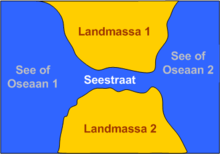Tidal strait
A tidal strait is not technically a river, but a strait, connecting two oceans, or seas. Tidal straits are narrow seaways through which flow tidal currents. Tidal current are usually uni-directional, but sometimes can be bi-directional. Frequently they are of tectonic origin. Currents in them develop due to elevation differences between the water basins at either ends.[1]

A tidal strait, between two landmasses
Due to tides, sediments can collect in tidal straits.[2][3]

Arthur Kill tidal strait, Prall's Island visible
References
- Longhitano, Sergio G.; Mellere, Donatella; Steel, Ronald J.; Ainsworth, R. Bruce (April 9, 2012). "Tidal depositional systems in the rock record: A review and new insights" (PDF). basin.earth.ncu.edu.tw. Retrieved 27 May 2019.CS1 maint: multiple names: authors list (link)
- Longhitano, Sergio; Steel, Ronald J. (June 2015). "Deltas sourcing tidal straits: observations from some field case studies". researchgate.net. Retrieved 27 May 2019.CS1 maint: multiple names: authors list (link)
- Rossia, V.M.; Longhitano, S.G.; Mellere, D.; Dalrymple, R.W.; Steela, R.J.; Chiarellae, D.; Olariua, C. (November 2017). "Interplay of tidal and fluvial processes in an early Pleistocene, delta-fed, strait margin (Calabria, Southern Italy)". Marine and Petroleum Geology. Retrieved 27 May 2019.CS1 maint: multiple names: authors list (link)
External links
This article is issued from Wikipedia. The text is licensed under Creative Commons - Attribution - Sharealike. Additional terms may apply for the media files.